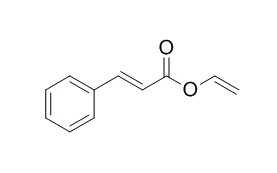Vinyl Cinnamate
Vinyl Cinnamate is a nartural product from Cinnamomum cassia Presl.
Inquire / Order:
manager@chemfaces.com
Technical Inquiries:
service@chemfaces.com
Tel:
+86-27-84237783
Fax:
+86-27-84254680
Address:
1 Building, No. 83, CheCheng Rd., Wuhan Economic and Technological Development Zone, Wuhan, Hubei 430056, PRC
Providing storage is as stated on the product vial and the vial is kept tightly sealed, the product can be stored for up to
24 months(2-8C).
Wherever possible, you should prepare and use solutions on the same day. However, if you need to make up stock solutions in advance, we recommend that you store the solution as aliquots in tightly sealed vials at -20C. Generally, these will be useable for up to two weeks. Before use, and prior to opening the vial we recommend that you allow your product to equilibrate to room temperature for at least 1 hour.
Need more advice on solubility, usage and handling? Please email to: service@chemfaces.com
The packaging of the product may have turned upside down during transportation, resulting in the natural compounds adhering to the neck or cap of the vial. take the vial out of its packaging and gently shake to let the compounds fall to the bottom of the vial. for liquid products, centrifuge at 200-500 RPM to gather the liquid at the bottom of the vial. try to avoid loss or contamination during handling.
Chem Pharm Bull (Tokyo).2017, 65(9):826-832
Phytomedicine.2023, 120:155063.
Int. J. Mol. Sci. 2022, 23(3),1696.
Asian Journal of Chemistry2014, 26(22):7811-7816
Biomol Ther (Seoul).2020, 28(6):542-548.
Molecules.2019, 24(6):E1155
Foods.2021, 10(11):2627.
Chin. Med.J.Res. Prac.2017, 31(4)
Int J Mol Sci.2024, 25(16):8846.
Antioxidants (Basel).2023, 12(2):447.
Related and Featured Products
Macromol Rapid Commun. 2014 Aug;35(15):1345-50.
Initiated chemical vapor deposition and light-responsive cross-linking of poly(vinyl cinnamate) thin films.[Pubmed:
24817405]
The first vapor-phase deposition of poly(Vinyl Cinnamate) (PVCin) is reported.
METHODS AND RESULTS:
Initiated chemical vapor deposition (iCVD) is used to synthesize Vinyl Cinnamate thin films with an average thickness of 100 nm. Free radical polymerization and cyclization reactions compete during the deposition process, with approximately 45% of the repeat units undergoing cyclization. Exposure to UV light (λ = 254 nm) induces dimerization (cross-linking) of the Vinyl Cinnamate, which is quantified using spectroscopic techniques. Approximately 90% of the free cinnamate moieties are dimerized at a UV dose of 300 mJ cm(-2) . Vinyl Cinnamate is also incorporated into a copolymer with N-isopropylacrylamide, which exhibits a characteristic change in hydrophilicity with temperature.
CONCLUSIONS:
The copolymer is selectively cross-linked through a mask, and reversible swelling of patterns with 30 μm resolution is demonstrated by submerging the film in water.
Biomacromolecules. 2013 Aug 12;14(8):2937-44.
Dispersibility and emulsion-stabilizing effect of cellulose nanowhiskers esterified by vinyl acetate and vinyl cinnamate.[Pubmed:
23883187]
The surface of cotton cellulose nanowhiskers (CNW's) was esterified by vinyl acetate (VAc) and Vinyl Cinnamate (VCin), in the presence of potassium carbonate as catalyst. Reactions were performed under microwave activation and monitored by Fourier transform infrared (FT-IR) spectroscopy.
METHODS AND RESULTS:
The supramolecular structure of CNW's before and after modification was characterized by X-ray diffraction (XRD) and atomic force microscopy (AFM). Distinctively from the acetylation treatment, an increase in particles dimensions was noted after esterification with VCin, which was assigned to π-π stacking interactions that may exist between cinnamoyl moieties. The dispersibility and emulsion stabilizing effect of acylated CNW's was examined in ethyl acetate, toluene, and cyclohexane, three organic solvents of medium to low polarity. The acylated nanoparticles could never be dispersed in toluene nor cyclohexane, but they formed stable dispersions in ethyl acetate while remaining dispersible in water.
CONCLUSIONS:
Stable ethyl acetate-in-water, toluene-in-water, and cyclohexane-in-water emulsions were successfully prepared with CNW's grafted with acetyl moieties, whereas the VCin-treated particles could stabilize only the cyclohexane-in-water emulsions. The impact of esterification treatment on emulsion stability and droplets size was particularly discussed.



